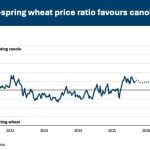GOODWATER, Sask. — Scientists converged on an abandoned farm-yard near this hamlet south of Weyburn, Sask., last week to finish testing water and soil for the presence of hydrocarbons.
The experts are part of an independent study conducted by the International Performance Assessment Centre for Geologic Storage of Carbon Dioxide (IPAC-C02) in Regina.
The study was announced earlier this year after the farm owners, Cameron and Jane Kerr, alleged that carbon dioxide was leaking from underground storage that is part of Cenovus Energy’s enhanced oil recovery project.
Read Also

Farmers urged to be grain-safe this fall
Working around grain bins comes with risk, from farmers falling to drowning in grain: Experts have five tips to help avoid grain-related accidents this harvest.
The Kerrs abandoned their farm home in 2005 after they heard explosions in a gravel pit behind their home and found dead animals beside water ponds in their yard.
In January, they asked for an independent investigation after a consultant they hired found unusually high C02 and methane levels.
IPAC-C02 chief executive officer Carmen Dybwad said experts from the University of Texas at Austin who tested for soil gases and water contaminants last week would be able to tell if unusual levels are present and if they occurred naturally or because of a leak.
The area is home to some of the heaviest energy sector development in Saskatchewan.
Dybwad said the tests were delayed by this year’s wet weather.
Stewart Gilfillan of the University of Edinburgh in Scotland was at the site in June to test for noble, or inert, gases in the ground between the reservoir and groundwater.
“He will be able to tell if they come from the (carbon) injections,” Dybwad said.
Gilfillan’s work will be combined with that of Katherine Romanak and Brad Wolaver of Texas in a report Dybwad said would be released by Dec. 12.
“We certainly didn’t want to put it off another year,” Dybwad said, referring to weather woes. “The question has been out in the community for a long time.”
Last week, Romanak was taking soil gas samples from 10 locations at depths of 60 centimetres to nearly six metres. Her work is taking up where Gilfillan’s left off.
She said she would be able to tell by the concentration whether the levels were naturally occurring or came as a result of the injection because there are accepted relationships between levels of co-existing gases.
The test sites are in a line from where the Kerrs’ consultant found the highest gas levels to low levels, she added.
“Carbon dioxide concentration can naturally be very high,” Romanak said.
Wolaver is analyzing water from three sites, including the Kerrs’ well and their neighbour’s well.
“Our goal is to help to lower the uncertainty of the sources of carbon dioxide,” he said.
He and Romanak have worked extensively at carbon capture and storage projects along the Texas gulf coast, where projects began 40 years ago.
Janis Dale of the University of Regina’s geology department is examining sediments in the water for the presence of hydrocarbons.
Dybwad said the testing will determine whether there has been a leak, but it will also help set a protocol for future investigations.
She said proponents of carbon storage around the world have been waiting to see what happens in southern Saskatchewan ever since the Kerrs raised their concerns at a news conference.
“Anybody that’s trying to get a project underway is facing an uphill battle since their press release,” she said.
The Kerrs, who now live in Regina, were at their former home during the testing. They said they were happy to see independent experts at work.
“We’ve been after this for seven years,” said Cameron.
While some of their neighbours support them, others don’t, he said.
“Our goal is to get regulations in the oil and gas industry because there aren’t any,” said Jane.
“That way something is in place if someone discovers a problem, instead of what we had to do.”















